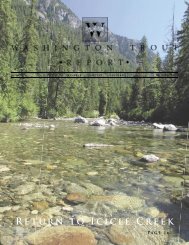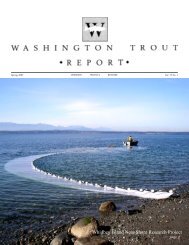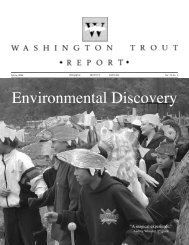Seafood Watch
Pacific Salmon - Wild Fish Conservancy
Pacific Salmon - Wild Fish Conservancy
- No tags were found...
Create successful ePaper yourself
Turn your PDF publications into a flip-book with our unique Google optimized e-Paper software.
<strong>Seafood</strong> <strong>Watch</strong>® Wild Pacific Salmon Report October 8, 2010<br />
Coho Salmon (Oncorhynchus kisutch)<br />
Coho salmon is also known as “silver” salmon. Of the five main Pacific salmon species, coho<br />
have proven to be the species perhaps most vulnerable to human pressure. While coho occupy<br />
the widest range of freshwater habitat types, they are not the most abundant species and have<br />
seen their numbers decline substantially throughout the southern portion of their range (Olsen et<br />
al. 2003).<br />
Distribution<br />
In North America, coho salmon spawn in many locations between the San Lorenzo River in<br />
Monterey Bay, California and Point Hope, Alaska in the Chukchi Sea (PFMC 2003). At sea,<br />
coho salmon range throughout the Pacific, from as far south as Baja California to Kotzebue<br />
Sound in the north. They are most frequently found in coastal waters between Central Oregon<br />
and Southeast Alaska (DFO 2001, PFMC 2004c).<br />
On the Asian side of the Pacific, coho salmon range throughout the Aleutian Islands, Kamchatka<br />
Peninsula, Hokkaido, Japan, and Korea (DFO 2001).<br />
ESUs<br />
Seven evolutionarily significant units (ESUs) of coho salmon have been identified on the West<br />
Coast of the United States:<br />
• Central California (Endangered under California Endangered Species Act)<br />
• Southern Oregon/Northern California Coasts<br />
• Oregon Coast<br />
• Lower Columbia River<br />
• Puget Sound/Strait of Georgia<br />
• Southwest Washington<br />
• Olympic Peninsula<br />
As of 2008, the Central California ESU is listed as endangered, the next three ESUs above were<br />
listed as threatened species, while the Puget Sound/Strait of Georgia ESU has a “species of<br />
concern” designation, all under the U.S. Endangered Species Act (NMFS 2010a). Additionally,<br />
coho south of Punta Gorda in California are listed as Endangered under the California<br />
Endangered Species Act.<br />
In Alaska, fishery managers have not divided coho salmon into ESUs. Instead fishery<br />
management is divided along geographic lines, splitting the state harvest into four overarching<br />
regions: Southeast Alaska, Central Region, Westward Region, and Arctic-Yukon-Kuskokwim<br />
Region. Coho salmon are harvested in all four of these regions, with a slight majority of landings<br />
coming from Southeast Alaska (Plotnick and Eggers 2004).<br />
Life History Traits<br />
Like the other species of Pacific salmon, coho salmon are anadromous, and generally have a life<br />
history similar to Chinook salmon. However, there are some differences between Chinook and<br />
coho salmon. Unlike Chinook salmon, the amount of time coho salmon spend in fresh and salt<br />
water is relatively fixed. Juvenile coho typically spend at least a year in freshwater, followed by<br />
25






